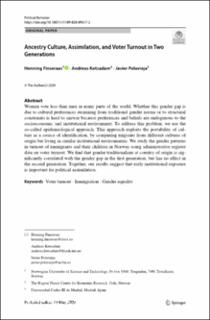| dc.contributor.author | Finseraas, Henning | |
| dc.contributor.author | Kotsadam, Andreas | |
| dc.contributor.author | Polavieja, Javier | |
| dc.date.accessioned | 2021-02-15T11:35:58Z | |
| dc.date.available | 2021-02-15T11:35:58Z | |
| dc.date.created | 2020-07-23T09:28:11Z | |
| dc.date.issued | 2020 | |
| dc.identifier.citation | Political Behavior. 2020, . | en_US |
| dc.identifier.issn | 0190-9320 | |
| dc.identifier.uri | https://hdl.handle.net/11250/2728060 | |
| dc.description.abstract | Women vote less than men in many parts of the world. Whether this gender gap is due to cultural preferences stemming from traditional gender norms or to structural constraints is hard to answer because preferences and beliefs are endogenous to the socioeconomic and institutional environment. To address this problem, we use the so-called epidemiological approach. This approach exploits the portability of culture as a source of identification, by comparing migrants from different cultures of origin but living in similar institutional environments. We study the gender patterns in turnout of immigrants and their children in Norway using administrative register data on voter turnout. We find that gender traditionalism at country of origin is significantly correlated with the gender gap in the first generation, but has no effect in the second generation. Together, our results suggest that early institutional exposure is important for political assimilation. | en_US |
| dc.language.iso | eng | en_US |
| dc.publisher | Springer | en_US |
| dc.rights | Navngivelse 4.0 Internasjonal | * |
| dc.rights.uri | http://creativecommons.org/licenses/by/4.0/deed.no | * |
| dc.title | Ancestry Culture, Assimilation, and Voter Turnout in Two Generations | en_US |
| dc.type | Peer reviewed | en_US |
| dc.type | Journal article | en_US |
| dc.description.version | publishedVersion | en_US |
| dc.source.pagenumber | 26 | en_US |
| dc.source.journal | Political Behavior | en_US |
| dc.identifier.doi | 10.1007/s11109-020-09617-2 | |
| dc.identifier.cristin | 1820262 | |
| dc.description.localcode | Open Access This article is licensed under a Creative Commons Attribution 4.0 International License, which permits use, sharing, adaptation, distribution and reproduction in any medium or format, as long as you give appropriate credit to the original author(s) and the source, provide a link to the Creative Commons licence, and indicate if changes were made. The images or other third party material in this article are included in the article's Creative Commons licence, unless indicated otherwise in a credit line to the material. If material is not included in the article's Creative Commons licence and your intended use is not permitted by statutory regulation or exceeds the permitted use, you will need to obtain permission directly from the copyright holder. To view a copy of this licence, visit http://creativecommons.org/licenses/by/4.0/. | en_US |
| cristin.ispublished | true | |
| cristin.fulltext | postprint | |
| cristin.qualitycode | 2 | |

